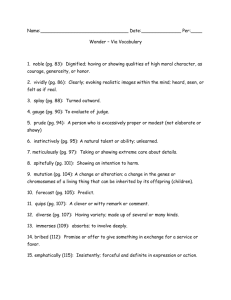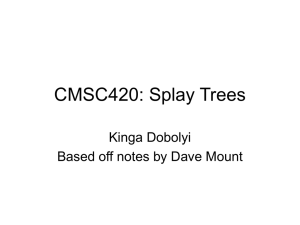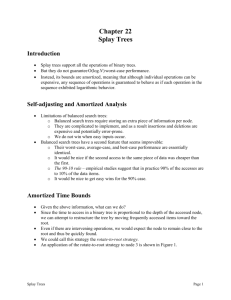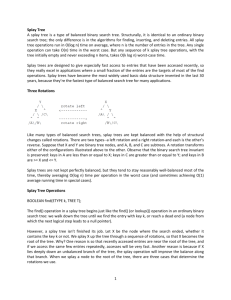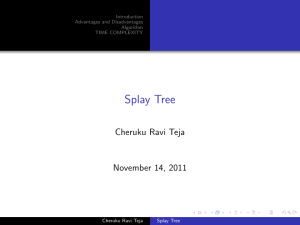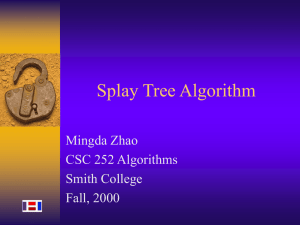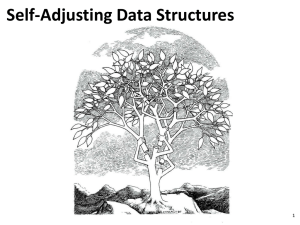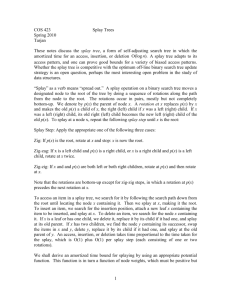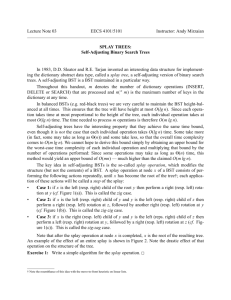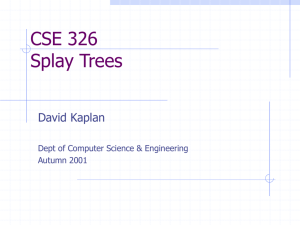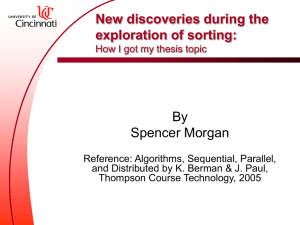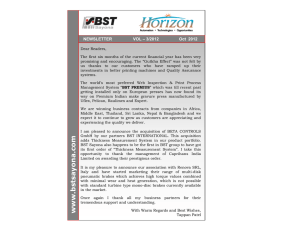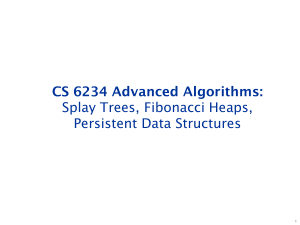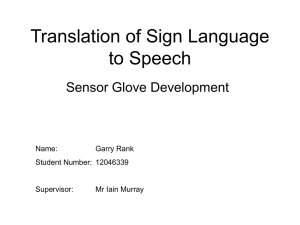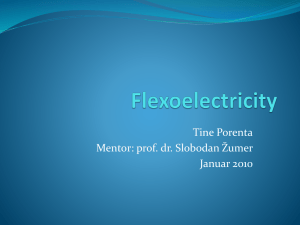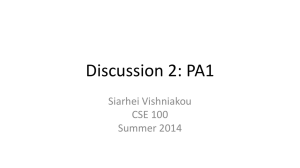Self-Adjusting Binary Search Trees
advertisement
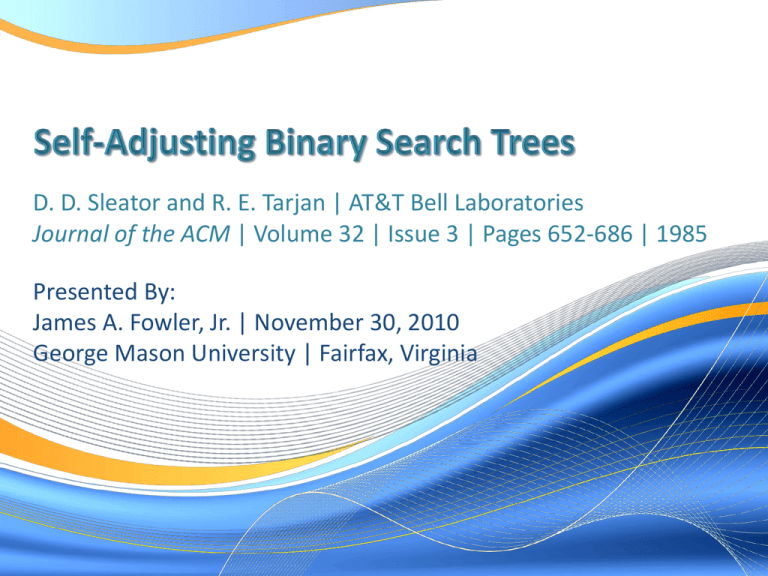
D. D. Sleator and R. E. Tarjan | AT&T Bell Laboratories Journal of the ACM | Volume 32 | Issue 3 | Pages 652-686 | 1985 Presented By: James A. Fowler, Jr. | November 30, 2010 George Mason University | Fairfax, Virginia Topics for Discussion – Paper and Authors – Splay Tree – Splaying – Basic Splaying Operations – Splay Tree Operations – Analysis – Applications and Further Research – References Paper and Authors D. D. Sleator and R. E. Tarjan, “Self-adjusting binary search trees,” Journal of the ACM, vol. 32, no. 3, pp. 652-686, 1985. http://www.cs.cmu.edu/~sleator/papers/self-adjusting.pdf Daniel Dominic Kaplan Sleator, PhD – Professor of Computer Science, Carnegie Mellon University Robert Endre Tarjan, PhD – James S. McDonnell Distinguished University Professor of Computer Science, Princeton University Splay Tree – A splay tree is a type of self-adjusting binary search tree (BST) that supports all BST operations (access, join, split, insert, delete) and reorganizes itself automatically on each access – The driving force behind splay trees is the concept that “for the total access time to be small, frequently accessed items should be near the root of the tree often” Splaying – Splaying is the key operation of splay trees – After a node is accessed, splaying moves the node to the root of the tree – There are two major methods of splaying: • Bottom-Up • Top-Down – Due to time constraints, I’ll focus on bottomup splaying Splaying – In bottom-up splaying, a splay tree element is accessed BST-style – If the element exists in the tree, the tree is splayed at that element before it is returned – If the element doesn’t exist, the tree is splayed at the last non-null element traversed Splaying – In bottom-up splaying, three basic splaying operations are repeated from the element being splayed up to the root – One of the three operations, zig, zig-zig, or zig-zag, is chosen based on the configuration of the element, its parent, and grandparent – To describe these operations, let x be the element being splayed, p(x) be the parent of x, and g(x) be the grandparent of x Basic Splaying Operation: Zig-Zig – If x and p(x) are both left or both right children and p(x) ≠ root 1) Rotate the edge joining p(x) and g(x) 2) Rotate the edge joining x and p(x) Basic Splaying Operation: Zig-Zag – If x is a right child and p(x) is a left child (or vice-versa) and p(x) ≠ root 1) Rotate the edge joining x and p(x) 2) Rotate the edge joining x (in its new position) and the original g(x) Basic Splaying Operation: Zig – Zig-Zig and Zig-Zag move x up two edges at a time—what about odd depths? – When p(x) = root and depth is odd, use Zig as a final splay step – Rotate edge joining x and p(x) Operation: access(i, t) – Inputs: Tree t and an element i to access – Output: A pointer to the node containing i or null if not found – Algorithm: 1) Traverse from the root of t going left if the current node is < i, right if > i, stopping if = i, or stopping and storing the previous node if = null 2) If traversal stopped at i, splay at i and return a pointer to the new root of t 3) Otherwise, splay at the previous non-null node and return null Operation: join(t1, t2) – Inputs: Trees t1 and t2 where all elements in t1 are less than all elements in t2 – Output: A single splay tree combining t1 and t2 – Algorithm: 1) 2) 3) 4) Access the largest element in t1 The root of t1 is now the largest element Point the null right child of t1‘s root to t2 Return t1 Operation: split(i, t) – Inputs: Tree t and a value i on which to split – Output: Trees t1 and t2 containing the elements of t < i and > i respectively – Algorithm: 1) 2) 3) 4) Perform access(i, t) If t’s root < i: t2 = right(t), right(t) = null, t1 = t If t’s root > i: t1 = left(t), left(t) = null, t2 = t Return t1 and t2 Operation: insert(i, t) – Inputs: Tree t and a value i to insert – Output: Tree t with element i inserted – Algorithm: 1) 2) 3) 4) 5) Perform split(i, t) to get t1 and t2 Create a new tree t with i in the root element Set left(t) = t1 Set right(t) = t2 Return t Operation: delete(i, t) – Inputs: Tree t and a value i to delete – Output: Tree t with element i removed – Algorithm: 1) 2) 3) 4) 5) Perform access(i, t) Save a pointer to the root node of t Perform join(left(t), right(t)) to get the new t Free the old root node of t Return the new t Analysis: Advantages – Never much worse than non-self-adjusting data structures – Need less space since no balance info needed – Adjustment to usage patterns means they can be more efficient for certain sequences – Splaying reduces the depth of the nodes on the access path by roughly half Analysis: All Zig-Zag Steps – In this example (accessing element a): • Depth of access path: 6 → 3 • Reduced by: 1/2 Analysis: All Zig-Zig Steps – In this example (accessing element a): • Depth of access path: 6 → 4 • Reduced by: 1/3 Analysis: Disadvantages – More adjustments – Adjustments on accesses, not just updates – Individual operations can be expensive Analysis: Comparison to Balanced BST – Balance Theorem [1] proves the total access time is O[(m+n)log n + m] for m accesses of an n-element splay tree – The average-case total access time for a balanced BST is m log n – For very large access sequences, the splay tree total access time is of the same order of a balanced BST Analysis: Sequential Access – Accessing all of the elements in sequential order of an n-element splay tree is O(n) – Tarjan [2] proved an upper bound of 10.8n rotations in 1985 – Elmasry [3] proved the best known upper bound so far of 4.5n rotations in 2004 Applications and Further Research – Double-Ended Queue (Deque) • Deque operations require sequential access when implemented using a splay tree • Deque conjecture [2] proposes that m deque operations on an n-element splay tree is O(n+m) • Tarjan [2] proved upper bound of 11.8n + 14.8m for the specific case excluding eject operations • Elmasry [3] proved upper bound of 4.5n + m for this same specific case Applications and Further Research – Associative Arrays – Priority Queues – Data Compression [4] • Douglas W. Jones of the U. of Iowa has done extensive research on this topic: http://www.cs.uiowa.edu/~jones/compress/ • He claims for images, it compresses as good as LZW and uses less memory References [1] D. D. Sleator and R. E. Tarjan, “Self-adjusting binary search trees,” Journal of the ACM, vol. 32, no. 3, pp. 652-686, 1985. [2] R. E. Tarjan, “Sequential access in splay trees takes linear time,” Combinatorica, vol. 5, no. 4, pp. 367-378, 1985. [3] A. Elmasry, “On the sequential access theorem and deque conjecture for splay trees,” Theoretical Computer Science, vol. 314, no. 3, pp. 459-466, Apr. 2004. [4] D. W. Jones, “Application of splay trees to data compression,” Communications of the ACM, vol. 31, no. 8, pp. 996-1007, 1988. Questions?

